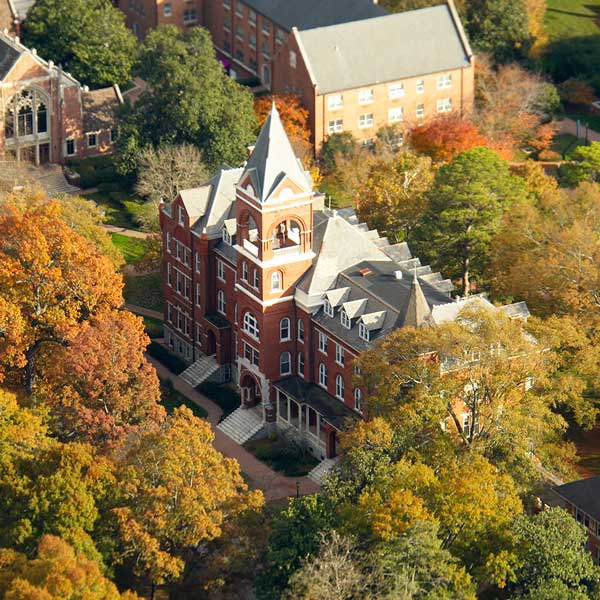Agnes Scott is planning and implementing a number of activities to reduce our energy use. In alignment with industry best practices, we have first focused on behavior change and increasing energy efficiency by prioritizing equipment replacement and building envelope improvement projects. These energy and water conservation projects have been funded through the college’s nationally recognized Green Revolving Fund. In conjunction with energy efficiency and water conservation efforts, the college was the first non-profit in the state of Georgia to install solar arrays on their campus in 2014.
Our energy reduction efforts stem from our commitment to the American College & University Presidents’ Climate Commitment. Agnes Scott signed the Climate Commitment in September 2007, as one of the charter signatories. We submitted our baseline greenhouse gas emissions inventory on September 15, 2008. Our first Climate Action Plan (CAP) was completed during the summer of 2009 and submitted to the ACUPCC on September 15, 2009. As stated in our 2009 CAP, the college is committed to achieving carbon neutrality of Scope 1 and 2 emissions by 2037.
Since 2024, the college has reduced its carbon footprint by over 50% for Scope 1 and 2 emissions.
You can track our progress on the Second Nature website here.
A climate action plan (CAP) is a roadmap for how an institution will reduce its net carbon emissions to zero over a certain period of time. Universities and colleges generate carbon emissions from their infrastructure, specifically by purchasing fossil fuel energy, utilizing greenhouse gas-emitting refrigerants, and 'indirect' sources, like travel for study abroad and daily commuting.
Our CAP strategy is to reduce our energy usage by installing higher-efficiency equipment and promoting energy-conservation behaviors, while increasing our renewable energy sources. Lastly, the college will use community-focused, local carbon offsets to cover the emissions that are impossible to avoid or replace.
The order of these actions is vital. First, we reduce our total energy demand by energy conservation (education) and energy efficiency (equipment upgrades). Then, we purchase renewable energy to transition our energy consumption to clean sources. Finally, we purchase community-focused, local carbon credits to offset the portion of our footprint we cannot avoid with efficiency, conservation, or renewables.
In 2007, former President Dr. Elizabeth Kiss signed the American College & University Presidents' Climate Commitment (ACUPCC), therefore, ambitiously committing Agnes Scott College to carbon neutrality by 2037.
The commitment, since then, has evolved into the Climate Leadership Commitment facilitated by the non-profit organization Second Nature. The transformation, however, did not only come in the form of a name change. We have also committed ourselves to setting a resilience strategy for our community, in conjunction with the City of Decatur. Despite challenges like campus community growth, and lack of innovative and robust renewable energy programs in Georgia, we have made significant progress toward our goal to reduce our net campus carbon footprint to zero.
Furthermore, the Center for Sustainability staff has revisioned the trajectory of our journey to carbon neutrality and gained further insight on solutions that fit our unique context.
Agnes Scott’s Sustainability Steering Committee (SSC) requested that the energy efficiency and alternative energy subcommittee that guided the GHG emissions inventory also guide the CAP.
This subcommittee has been led by three co-chairs: our director of facilities, a chemistry professor, and an alumna who served as a member of Georgia’s Public Service Commission. The co-chairs and other subcommittee members met several times in the fall of 2008 to discuss what information was needed in order to decide on potential carbon emissions reduction goals. The same student intern who conducted the GHG emissions inventory collected the necessary information as a work-study student in 2008-2009. Together with the college’s sustainability staff, she also reviewed climate action plans and reports, along with case-studies from other colleges and universities.
In the spring of 2009, the subcommittee looked at potential reduction goals and agreed to report on several reduction scenarios to the full SSC and the Board of Trustees. The reduction estimates were based on specific research, such as:
- Conservation: estimates based on available information about past reductions at Agnes Scott due to conservation messaging. Also based on research about reductions achieved at other colleges and universities.
- Efficiency: estimates based on a three-phase mechanical retrofitting plan combined with energy saving projects from the deferred maintenance plan.
- Renewable energy: estimates based on a professional assessment of potential roof-top solar capacity.
- The SSC and Trustees responded with support for the scenarios, asking the subcommittee to return with refined reduction options.

